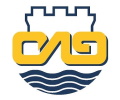Damen Plays Leading Role In Dutch Drive To Autonomous Shipping

For the past two years Damen has been involved in the Joint Industry Project (JIP) Autonomous Shipping, a two-year research project based in the Netherlands that started in 2017 with the aim of advancing the technology required to allow vessels to conduct certain operations autonomously. The project brought together 17 Dutch companies and organisations, led by the Netherlands Maritime Technology.
SUCCESSFUL FIRST TRIAL
On 19 and 20 March this year, the project reached a key milestone with a series of initial trials taking place in the North Sea off Den Helder using SeaZip 3, a Damen Fast Crew Supplier 2610 owned by SeaZip Offshore Services. Their purpose; to demonstrate the progress made on the project so far. For the trial, collision avoidance technology was supplied by Robosys Automation with Damen Development Engineer Siebe Rooijakkers performing the integration with the autopilot and the propulsion control systems on board the SeaZip 3. This was followed by the two days of trials to study how the vessel interacted with seagoing traffic while underway without direct human involvement. In all, eleven scenarios were run with two other vessels playing the part of routine shipping and involved collision avoidance as well as safe sailing.
The trial was considered a success and work is now continuing on further development to enable the technology to cope with complex marine traffic situations in a more efficient way. The demonstration is also contributing to the creation by the JIP of an autonomous shipping roadmap that is intended to guide the industry in what needs to be done to make autonomous shipping a reality, including non-technical issues such as regulation and risk management.
MORE AUTONOMY DOES NOT HAVE TO MEAN ZERO CREW
“At Damen we don’t so much see them initially as unmanned ‘ghost’ vessels ploughing the oceans in silence, as ships where a number of tasks are automated, allowing a smaller crew to handle those tasks that still require the human element, such as the various activities that take place when the vessel arrives in the port. Freeing up crew from mundane and repetitive tasks would also increase safety and efficiency. The sorts of tasks that would be the first to be automated depends on the kind of vessel. After all, ships have had autopilots for years and so we are looking to build on that by automating additional bridge functions. Dredging is another area that has obvious scope for automation, for example.”
While the JIP decides on its next moves, Damen continues with its own internal automation projects. “We are in ongoing discussions with our industry partners as to where they would like to see automation to incrementally expand its role, and so we see it as an evolving process, with human involvement required on board for some time to come,” says Marco. “I am personally working on vessel monitoring, which we used in the JIP demonstration to record the vessel movements. That data is now being used in the follow-up report to assist in the analysis of the vessel performance. The same system is being rolled-out right across the Damen fleet and is generating large amounts of data that we can use to improve vessel designs through the insights that we gain as they go about their duties. Over time we can identify trends which means that we can predict what will happen under certain circumstances. This is very valuable information when it comes to developing automation systems.”
Source: Damen

 Hellenic Shipping News Worldwide Hellenic Shipping News Worldwide, Online Daily Newspaper on Hellenic and International Shipping
Hellenic Shipping News Worldwide Hellenic Shipping News Worldwide, Online Daily Newspaper on Hellenic and International Shipping























 PG-Software
PG-Software